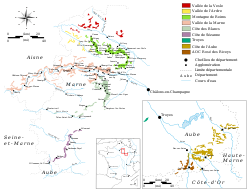Rosé des Riceys
The Rosé des Ricey is a rosé wine from a defined designation of origin . The Rosé des Riceys wine region has had AOC status since February 2, 1971 . Only vineyards within the municipality of Les Riceys , which in turn consists of the hamlets of Riceys-Haut , Haut-Rive Riceys and Riceys-Bas , are permitted for growing the wine . With 750.4 hectares , the commune of Les Riceys has the largest vineyard area in a commune in the Champagne wine-growing region . In addition, it is the only municipality in this growing area that is allowed to market its wines under three different denominations of origin: the sparkling wines as champagne , the still wines as coteaux champenois or rosé des Riceys. Les Riceys is the southernmost municipality within the Champagne wine-growing region and is located in the Laignes valley , a left tributary of the Seine . There limestone soils from the geological age of the Kimmeridgian are exposed.
In 2008, only 360 hectoliters of Rosé des Riceys were declared. This is the equivalent of around 48,000 bottles of wine. In normal years around 60,000 bottles are filled by 20 winemakers.
Grape varieties
In general, the yields are limited to 13,000 kg of grapes / hectare. With a maximum pouring of 105 liters / 160 kg of grapes, the yield per hectare is a very high 85 hl / ha.
The rosé wines are made from the Pinot Noir grape variety . In the first drafts of the decree from 1947, admixtures of the Gamay and Savagnin Rose grape varieties were planned. Before fermentation , the natural minimum sugar content of the must must be 170 g / l, which corresponds to an alcohol content of 10.5 percent by volume in the wine (see must weight ).
Two methods are used to make the rosé:
- The expansion takes place in steel tanks. This wine should be drunk in its youth within 2-3 years.
- The wine is aged in wooden barrels for 1–2 years. This wine has a better aging potential of 4 to 8 years.
Ideally, the wines have a scent of ripe cherries , raspberries and black currants. Furthermore, a fine note of almond tones, vanilla , grenadine and bergamot mixes into the nose of the wine. However, this bouquet , known as goût des Riceys , only appears after a precisely measured maceration time .
history
In the Champagne it is often rumored that the Sun King Louis XIV already liked the Rosé des Riceys. There are two legends about the origin of the connection to the royal family:
- Nicolas Viaot, a lawyer from Riceys, was attacked by a royal musketeer for no reason in 1698 , but won the duel . Viaot then had to fear sanctions and went into hiding. However, the evidence was good, so the king pardoned the lawyer. As a thank you, Nicolas Viaot sent the king a barrel of Les Riceys rosé wine.
- Craftsmen from the community of Les Riceys worked on the foundations of Versailles Palace . Since they constantly worked in the damp trenches, they were called canats , a corruption of the word canard ( French : duck ). It is described that the craftsmen had a barrel of their Rosé des Riceys on site and one day offered the wine to a nobleman interested in the construction site. The nobleman was none other than the king himself, who enjoyed the rosé wine and made it popular at court.
literature
- Jancis Robinson : The Oxford Wine Lexicon . 3. Edition. Gräfe and Unzer Verlag, 2007, ISBN 978-3-8338-0691-9 .
- Pierre Galet : Cépages et Vignobles de France . Lavoisier Publishing House, Paris 2004, ISBN 2-7430-0585-8 .
- Benoît France (ed.): Grand Atlas des Vignobles de France . Solar publishing house, Paris 2002, ISBN 2-263-03242-8 .
Individual evidence
- ↑ maisons-champagne.com website of the Maisons-Champagne (in French)
- ↑ Le guide Hachette des Vins 2010 . ISBN 978-2-01-237514-7
